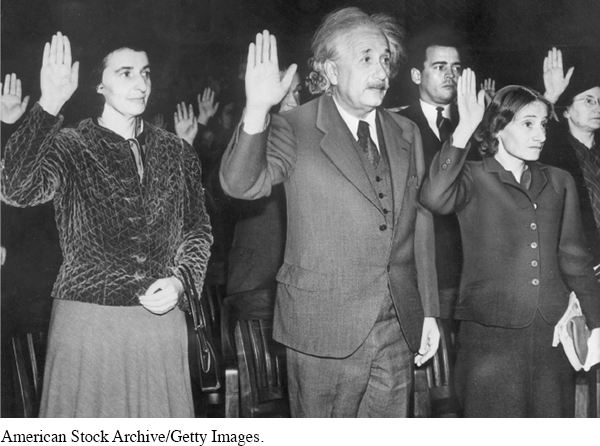The American Promise: Printed Page 732
The American Promise: A Concise History: Printed Page 760
BEYOND AMERICA’S BORDERS
The American Promise: Printed Page 732
The American Promise: A Concise History: Printed Page 760
Page 732Nazi Anti-
During the 1930s, Jewish physicists fled Adolf Hitler’s fanatical anti-
One of Germany’s greatest scientists, Albert Einstein, won the Nobel Prize for physics in 1921. Among other things, Einstein’s work demonstrated that the nuclei of atoms of physical matter stored almost inconceivable quantities of energy. A fellow scientist praised Einstein’s discoveries as “the greatest achievements in the history of human thought.” But Einstein was a Jew, and his ideas were ridiculed by German anti-
In his manifesto, Mein Kampf, Hitler proclaimed that Jews were “a foreign people,” “inferior beings,” the “personification of the devil,” “a race of dialectical liars,” “parasites,” and “eternal bloodsuckers,” who had the “clear aim of ruining the . . . white race.” Hitler’s rantings attracted a huge audience in Germany, and his personal Nazi army, which numbered 400,000 by 1933, terrorized and murdered anyone who got in the way.
In January 1933, just weeks before Franklin Roosevelt’s inauguration as president of the United States, Hitler became chancellor of Germany on a tidal wave of popular support for his Nazi Party. Within months, he abolished freedom of speech and assembly, outlawed all political opposition, and exercised absolute dictatorial power. On April 7, Hitler announced the Law for the Restoration of the Professional Civil Service, which stipulated that “civil servants of non-
The refugee physicists scrambled to find positions at American universities and research institutes that would allow them to continue their studies. The accelerating pace of research in physics during the 1930s raised the possibility that a way might exist to release the phenomenal energy bottled up in atomic nuclei, perhaps even to create a superbomb. Einstein and other scientists considered that possibility remote. But many worried that if scientists loyal to Germany discovered a way to harness nuclear energy, Hitler would have the power to spread Nazi terror throughout the world. The refugee physicists asked Einstein to write a letter to President Roosevelt explaining the military and political threats posed by the latest research in nuclear physics.
In early October 1939, as Hitler’s blitzkrieg swept through Poland, Roosevelt received Einstein’s letter and immediately grasped the central point, exclaiming, “What you are after is to see that the Nazis don’t blow us up.” Roosevelt quickly convened a small group of distinguished American scientists, who convinced the president to mount an all-
Leading scientists from the United States and Britain responded to the government’s appeal: “No matter what you do with the rest of your life, nothing will be as important to the future of the World as your work on this Project right now.” Many of the most creative, productive, and irreplaceable scientists involved in the Manhattan Project were physicists who had fled Nazi Germany. Their efforts had brought the possibility of an atomic bomb to Roosevelt’s attention. Having personally experienced Nazi anti-
In the end, Hitler’s scientists failed to develop an atomic bomb, and Germany surrendered before the American bomb was ready to be used. But the Manhattan Project succeeded, as Paul Tibbets proved over Hiroshima, Japan, on August 6, 1945. After the war, Leo Szilard, a leader among the refugee physicists, remarked, “If Congress knew the true history of the atomic energy project . . . it would create a special medal to be given to meddling foreigners for distinguished services.”

Questions for Analysis
Summarize the Argument: How did German anti-
Analyze the Evidence: Why did Jewish physicists leave Germany for the United States?
Consider the Context: Why were German Jewish scientists accepted into American society at a time when Japanese Americans were isolated in internment camps?
Ask Historical Questions: In what ways were the United States’ development and use of the atomic bomb “important to the future of the World”?